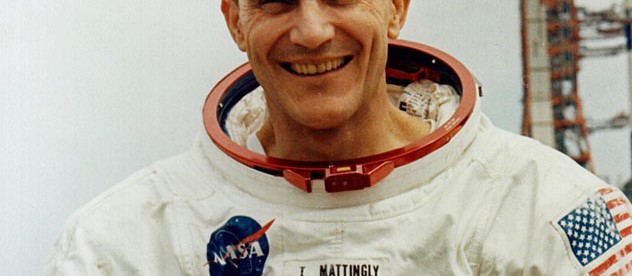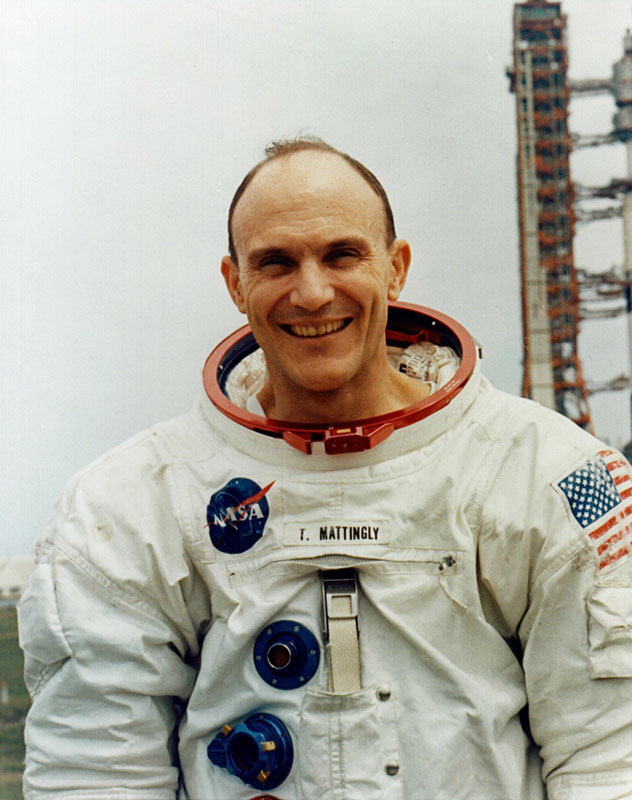Ring Around the Lunar Orbit


The man pictured above is Ken Mattingly, and he’s been somewhere you haven’t — to the moon. Mattingly isn’t a household name like Apollo 11 heroes Neil Armstrong, Buzz Aldrin, or Michael Collins (who, isn’t really a household name but should be). But in 1972 — three years after Apollo 11’s success — Mattingly was part of a three-man return trip. His colleagues astronauts John W. Young and Charles Duke became the 9th and 10th person, respectively, to take a stroll across the lunar landscape — Mattingly remained in lunar orbit. But Mattingly did something none of the moonwalkers did, on that trip or any other:
He lost his wedding ring in space.
If you’ve ever seen a video of astronauts doing things in microgravity, you’ll quickly see that objects go in directions unlike they do here on Earth. (Here’s a video of an astronaut ejecting a floppy disk from a computer if you want an example.) Keeping track of things is something one can’t take lightly, but accidents happen.
According to Duke in this interview, on the second day of the mission, Mattingly’s ring was a victim of one of those accidents. Mattingly was bathing — a sponge bath, which makes sense given the environment — and put all of his clothes in a pouch. That included his wedding ring, but when Mattingly re-opened the pouch and got dressed again, the ring was no longer in the bag. And while the spacecraft was small, the ring was nowhere to be found.
Two days later, Apollo 16 arrived on the moon — and the ring was still lost. Duke and Young spent three days on the moon and when they went back to the command module for the return trip, Mattingly was still looking for the ring. It seemed to be lost forever, hidden somewhere among the space equipment.
And then, on day 9, the ring appeared — and tried to run away. Duke and Mattingly both went out on a spacewalk. That, as Wired reported, is when Duke spotted the ring:
As he [Duke] turned to head back in, something caught his eye, small, glistening in the sun, floating slowly out of the door. He reached his big gloved hand out to catch the ring and missed. “Well,” he thought, “lost in space.”
Duke, Mattingly, the ship, and the ring were flying through space together at 3,000 feet per second, but in the absence of wind resistance, as Duke puts it, things just “move along together.” So there they were, floating while really zooming along—Charlie watching the unrushed ring head to its fate in the vast darkness.
But fate had something else in mind.
Duke came back into the module; Mattingly was still out on his walk, conducting a biological experiment while about ten feet away, connected via a tethering rod. As Duke recounted in the above-linked interview: the ring “slowly floated out — took about three minutes — and it ended up hitting [Mattingly] on the back of the head.” And despite incalculable odds, the ricochet was a near-perfect one. Per Duke, the ring “took an 180-degree bounce and started back down the hatch” and it “floated back in the hatch, into the spacecraft.”
Duke, who was standing there, was able to grab the ring before it could get lost again.
Bonus fact: One’s own kitchen is not as exotic of a place to lose a wedding ring as a spaceship is, but it can lead to a seemingly ridiculous discovery. According to a Swedish woman named Lena Paahlsson, she lost her ring in 1995 while cooking. Sixteen years later, it turned up — on a carrot in her garden. As the BBC reported — and that link has a picture of the ring-encircled carrot — Mr. and Mrs. Paahlsson “believe the ring fell into a sink back in 1995 and was lost in vegetable peelings that were turned into compost or fed to their sheep.”
From the Archives: Lunar Art: The stuff intentionally left behind.
Related: The One Ring. A replica, one hopes.
